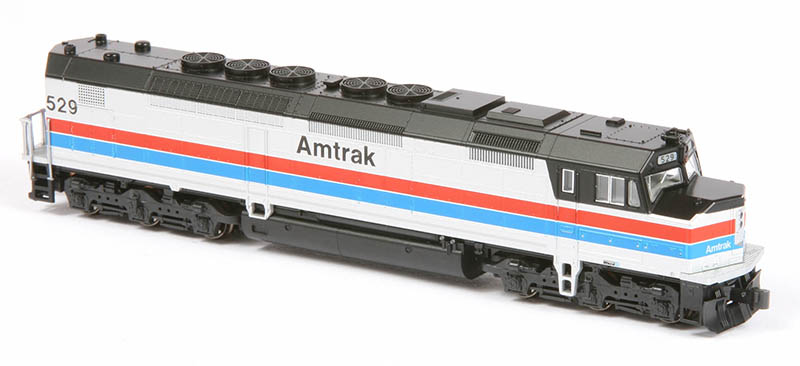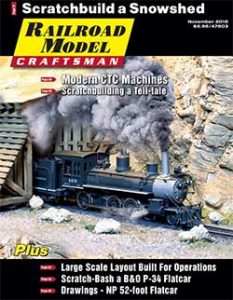 Reviewed by David Otte
Reviewed by David Otte
Kato has always been a strong supporter of Amtrak for N-scale fans and has recently turned its attention to the rail passenger carrier’s very first new equipment purchases. The Japan-based manufacturer is offering Electro-Motive Division’s (EMD) SDP40F diesel-electric locomotive in the Type I body style decorated in both Phase I and Phase II Amtrak paint, while its introduction of Budd Amfleet I passenger cars are debuting in the prototype’s as-delivered Phase I colors in both a specially packaged four-car set and twocar add-on sets.
When Amtrak took over the nation’s passenger rail operations on May 1, 1971, few could consider it a cohesive network of operations. It had at its disposal a hodgepodge of more than 1,000 passenger cars donated by the railroads and trackage rights nationwide over the freight carriers’ rails, as mandated by Congress through the 1970 Rail Passenger Service Act (RPSA), but little else. Locomotives, stations, maintenance facilities, and personnel were all private railroad responsibilities, which Amtrak had to lease or buy in its first several years of operation.
However, as the mid-1970s approached, Amtrak sought out new passenger equipment in an effort to make passenger rail travel more inviting to the public. Its initial purchase orders included 150 SDP40F diesels from EMD and 492 Budd-built Amfleet passenger cars.
The EMD SDP40F
To meet Amtrak’s request for six-axle long-distance passenger motive power, locomotive manufacturer EMD turned to its recently introduced SD40-2 freight model, which was receiving rave reviews from the industry at the time. Stretching the SD40-2’s frame length by about four feet (72-feet, 4-inches versus 68-feet, 10-inches) and borrowing the full-width body cowl and cab arrangement developed for the FP45 passenger locomotive back in 1967 made up EMD’s first steps toward the new SDP40F. The builder incorporated its new 16-cylinder 3,000-hp turbocharged 645-E3 prime mover, Dash 2 modular electronic system, and twin steam generators into its new passenger power and placed the locomotive atop a pair of hollow bolster versions of EMD’s new three-axle HT-C trucks. Delivered between June and July 1973, the first 40 SDP40Fs (500-539) were placed into service immediately.
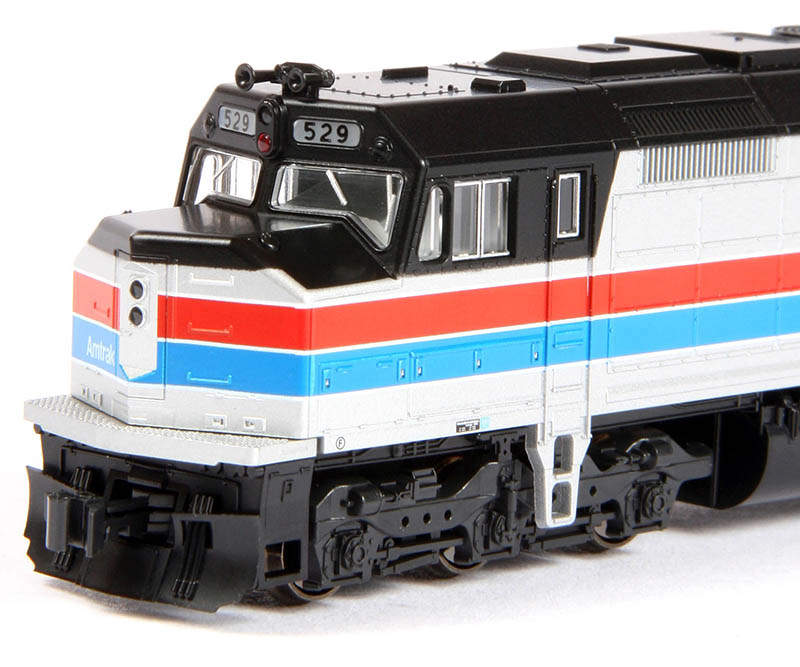
Pleased with early feedback, Amtrak management immediately placed an order for 110 more units (540– 649), which were delivered between April and June 1974, and can be distinguished from the earlier SDP40Fs by having a flat nose and nose door, whereas the initial 40 units displayed a pointed nose with headlight recessed into the door panel (a carryover from the FP45).
Initial successes were short-lived, as the SDP40F fleet soon began to experience a series of mysterious derailments, one even causing a fatality. Investigations behind the trouble were never conclusive, although the new truck design was suspect as was the imbalance the locomotive suffered due to the water tanks supplying the steam generators being located both above and below the frame. Nonetheless, between the negative press coverage, delayed train schedules, and the fact that a number of roads even forbid operations of the locomotive over their tracks, the whole ordeal caused Amtrak to rethink its locomotive strategy.
Meanwhile, help was on the way. By early 1976, EMD was delivering Amtrak’s new four-axle F40PH diesel-electric locomotive. Based on the GP40-2 freight locomotive and designed for service on commuter and medium-range passenger trains, the modern F-unit quickly proved to be quite adept at handling long-distance trains too. As more units came online, Amtrak began to scale back its use of the SDP40F, eventually trading in a good portion of the fleet on F40PHs. By the spring of 1981, the last of the troublesome diesels were off the active revenue-earning roster. After a 1984 trade deal sending examples to Santa Fe, 18 units would still see some noteworthy service in the Southwest, albeit modified for freight service (re-designated as SDF40-2s by Santa Fe) and remaining in use until as late as mid- 2002 on BNSF.
Budd Amfleet Passenger Cars
The Amfleet passenger cars were Amtrak’s first new rolling stock equipment since its formation in 1971. The new Budd-built cars followed the design of the popular Northeast Corridor Metroliners introduced in the late 1960s. The electrically heated and cooled passenger cars featured lightweight carbodies of a tubular design (85-foot long by 10- foot, 6-inches wide) — a vast departure from the traditional rectangular-shaped passenger cars in service over the past three decades. The Amfleet cars featured shot-welded fluted stainless steel panels, which offered an appearance akin to a modern airliner inside and out. Amtrak ordered 492 cars, which included 271 short-distance 84-seat coaches; 90 longdistance 60-seat coaches; 54 café cars with seating for 56; 37 dinette cars with 23 coach seats; and 40 club cars with seating for 46 passengers.
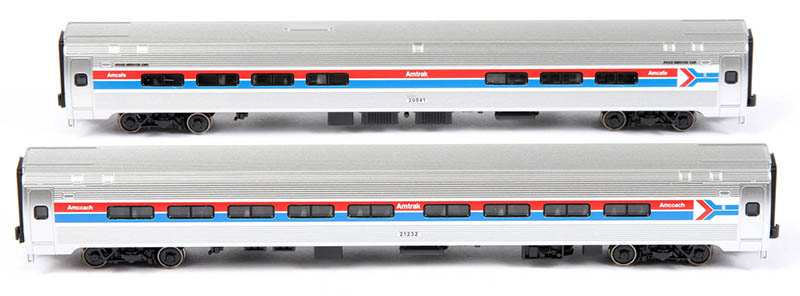
Deliveries began in 1975 and extended on through 1977. While the cars were used more heavily in the Eastern portion of the country, Amfleet consists did eventually show up in the Midwest and on the West Coast as well. In the 1990s and 2000s, most of the cars received refurbishment with upgraded electrical and mechanical systems and revised seating arrangements, at which time they saw renumbering from the original 20000-series to the 40000- and 80000-series.
Pleased with patron response to the cars, Amtrak went back to Budd again in 1981 for an additional 150 cars for use in longdistance service. Referred to as Amfleet II equipment, they differed visually from the earlier cars, now dubbed Amfleet I, by having a vestibule at one end of the car only. There are currently some 459 Amfleet I cars still in service.
Fine N Scale Models
Once again, Kato is making industry history with its introduction of these early Amtrak equipment renderings in 1:160. The SDP40F has been long sought after by N-scale modelers and the Amfleet I cars are a “must have,” whether modeling Amtrak’s early decades or today.
In most respects, the attributes of these new models are typical of Kato’s well-regarded product line. Both the 5.425-inches-long (over the anti-climbers) locomotive and 6.375-inch-long (over the diaphragms) passenger cars match their respective prototypes in general scale dimensions closely. Builder diagrams and photographic records also support the judgment that these models feature correct details too with the majority of the attributes, such as car body battens or fluting, rivets, ac-cess panels, door hardware, handholds, and air vents, crisply molded in the onepiece plastic carbodies and separate underframes. However, where warranted, add-on parts are used, including window glazing with gaskets or framing represented accordingly, the presence of the proper cab or car interior inserts molded in color, and clear lenses in place for headlights, number boards, or marker lights as appropriate.
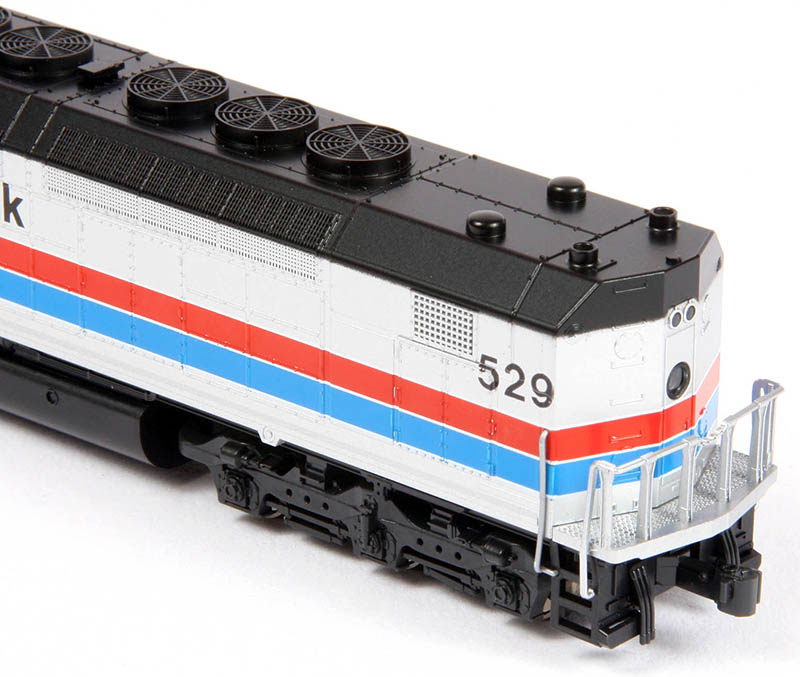
Furthermore, this Type I carbody SDP40F with a pointed nose and recessed door features factory-installed front pilot, plow, and hoses. The rear deck assembly displays raised tread plate with separate end rail and handrail beside the steps. The proper four-chime horn sits atop the cab, a partitioned water and fuel tank is mounted under the frame, and well-executed one-piece HT-C sideframes are on the trucks.
In turn, the Amfleet coach and café body styles both reflect hand-applied non-functioning end-of-car diaphragms, as well as excellent renderings of Budd’s Pioneer III inside-bearing trucks. You can enhance the passenger car models further with Kato’s separately sold LED lighting kits. Kato provides electrical pickups and metal wheelsets into the design for the trucks, making the interior illumination project a simple one.
Kato maintains its consistency in quality in these models’ decoration as well. Atlas previously released an SDP40F in the as-delivered Phase I scheme with a red nose, silver carbody, black roof and underbody, and Amtrak’s pointless arrow logo. Now comes this spectacular Phase II painted model, which Amtrak introduced on its locomotives in 1976. The new scheme featured a wide red-and-blue band stretching around the mostly aluminum lacquer-painted carbody with narrow white stripes defining its edges. Kato has captured this scheme perfectly, including sharp opaque lettering for the road name — correctly positioned midcar side — and the road number at the rear. Like the initial release, the Phase II model is available in two road numbers. Railroad Model Craftsman’s model for review, Amtrak No. 529 (535 is the other available road number) represents a unit built in July 1973 and retired by early 1978, at which time it was traded into EMD and reincarnated into F40PHR number 284.
Likewise, the Amfleet I cars are very patriotic in appearance with the same striping arrangement along the window band but featuring the pointless arrow logo of the road’s early years. Also well executed, these cars are available in a special four-car set, which includes three uniquely numbered coaches and a café car all delivered in one of Kato’s characteristic green collector bookcase boxes. Kato offers two different two-car add-on sets as well: Set A features two coaches, and Set B has a coach and café — all with different road numbers. Amfleet I cars in the current Phase IV paint scheme are also available from an earlier production run. We received both the four-car collection and Set B for this review, with the former including coach numbers 21116, 21214, and 21253 plus Café 20030 and the add-on cars featuring coach 21232 and Café 20041.

Finally, we come to the great operational aspects of these eye-catching gems — another Kato hallmark. To begin with, Kato bases its SDP40F mechanism on the company’s well-regarded N-scale SD40–2 drive system. A precision can motor with dual flywheels is embedded within the model’s metal chassis, the basis for much of the model’s 5.6-ounce weight, and all axles are geared. Electrical conductivity via all 12 drive wheels continues to be achieved through the manufacturer’s usual needlepoint axle pickup arrangement. In turn, these pickups make contact with sprung copper strips integrated within the length of the chassis that also provide downward pressure on the trucks — referred to by the manufacturer as “shock absorber construction.” This design feature offers positive electrical transmission regardless of track operating parameters, which, in the case of the SDP40F, includes minimum 9¾-inch radius curves.
Atop the chassis sits the lighting circuit board that provides directionally controlled golden white LED illumination for the headlights and number boards. You can easily replace this circuit board with a custom decoder for operation with Digital Command Control (DCC). Furthermore, if you prefer to have the DCC work done for you, you can also choose an SDP40F from Kato’s Kobo Shops with an ESU-LokSound DCC and sound decoder already installed for an additional cost.
Whether direct current or DCC operation, though, one will find these Kato renderings to operate as expected — smooth and silky, and void of any of the mysterious derailment issues that plagued the prototype! The samples’ slow speed performance of 4 scale miles per hour at the minimum starting volt-age of 2 volts was excellent; at 12 volts, the model approached an incredible 190 scale miles per hour; the prototype’s 50:20 gearing limited these locomotives to about half that speed. Finally, these miniature SDP40F’s one-ounce drawbar pull was better than anticipated (without the aid of traction tires, I might add), easily handling a consist of 20 Kato passenger cars of mixed vintage on level track and around more acceptable-looking 12.375-inch radius curves.
Just as I did before testing the locomotive, I checked the wheel gauge and coupler height on each of the passenger car samples with a National Model Railroad Association Standards Gage, to which they fully complied. While the Kato proprietary truck-mounted couplers on the passenger cars are not prototypical as such (locomotive is equipped with body-mounted couplers, however), their included consumer-applied trip pins do offer them similar operating characteristics to those of the more accepted industry standard — Micro-Trains.
Weighing in at 1.1 ounces, each passenger car is about 0.4 ounces under the NMRA’s recommended car weight based on length formula, but I experienced no operational anomalies when the six-car consist was set in motion around our test pike. Again, 9.75-inch radius curves are the minimum these cars can handle, but they look so much better on the larger curves.
Kato has accomplished its usual fine job in bringing yet another significant group of Amtrak prototypes to the 1:160 market. For a more up close and personal experience, the discriminating Nscale modeler will find these new pieces of diminutive eye-candy at their local dealer now with the SDP40F garnering a suggested retail price of $125. The four-car bookcase set lists at $125, and the two-car add-ons are $55 each.
Kato USA, Inc.
100 Remington Road
Schaumburg, IL 60173
847-781-9500



